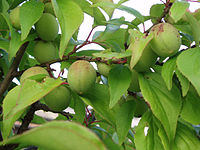Draft:Sour apricots (Ô mai)

Ô mai (Chinese: 烏梅, meaning: black plum), also known as xí muội by the pronunciations of Yue Chinese sounds "syun1 mui4" from Sino-Vietnamese word Toan mai (酸梅), means sour apricot. Ô mai originates as a medicine in the traditional medicine in many countries like Vietnam or China, but now, ô mai is usually mentioned as a snack, like candy, confectionery,...
Process[edit]
In traditional medicine[edit]

The Chinese prepare it in the following way: they take apricots that are almost ripe, wet them with straw ash, put the apricots back in and then dry the ripe fruit.
Vietnamese take almost-ripe apricots that are soft and not too ripe, then take out to dry for 3 - 4 time until dry. After that, soak in soot then bring out to dry, repeating many times. Or take green apricots, dry them, leave on the kitchen rack for six months, then we get sour apricots.
In traditional medicine, Ô mai is usually made by picking ripe apricots that are yellow, dry until sere, then dry again in a special way (dry, soak in salt water then dry agian for nine times). After it is all done, the apricot's met shrivels, looks black ("ô" means black), fine white salt crystallize on the surface (called bạch mai).
In cuisines[edit]
Ô mai is also the name for products fron fruits that are also make like it. The main ingredients to make sour apricots are friuts like apricots, plums, lemons, tamarind, peaches, canariums, kumquats, starfruits, mangoes, jackfruits, chinese apple, ...
To have an own unique color and flavor of ô mai, each place has its own secrets with many steps that require care and sophistication.
First of all, they must choose fruits that are good and healthy, no worms or bruises. They will then be washed, salted, dried and steamed. After this step, the ingredients are soaked and processed (fried, dried) into the final product in combination with spices such as sugar, salt, ginger, chili, licorice...Just from those fruits, they can cook into many dishes with many diffrent unique flavors: There are sour types; sweet types; There are types that combine all spicy, sour, salty, and sweet flavors; There is a type of wet stir-fry; and there are many other types that leave it very dry. The fruits then haves names including "ô mai" combined with the name of the main ingredient and processing method such as: "Sour and salty ginger apricot", "spicy plum apricot", "dried licorice tamarind apricot"...
Use[edit]
In traditional medicine[edit]
From traditional medicine, ô mai has cooling properties, reduces coughs, and produces new fluids.
In folks, ô mai is used as a cough suppressant, against dry throat, sore throat, hoarseness, used as a decoction or lozenge. It can also be combined with honey or ginger to increase the effect of cough relief, especially coughs due to colds, colds or coughs due to sore throat.
In oriental medicine, ô mai is a medicine combined with many other herbs to treat perennial coughs, long-term coughs, hoarseness, bronchitis, and sore throat.
Hải Thượng Lãn Ông has analyzed that coughing is from too much phlegm in the throat and that: "Ô mai has a sour taste, has astringent properties, can rise and fall, helps facilitate the flow of air (except coughs), and kills phlegm."
Today, ô mai is still used according to folk experience, using in traditional medicine, and are combined to prepare some types of oriental cough medicine.
In cuisines[edit]

Based by the original name, "ô" means black, "mai" means apricots. "Ô mai" means a black fnate it wruit made from apricots. To turn in into foods, apricots is seasoned with dried ginger or licorice powder. Ô mai is commonly used as a treat and is beloved by many people. Later, the ingredients for making these special fruits were expanded to include many different types of fruits, some processing method is to dry it, then marinate with many spices such as sugar, ginger, chili, licorice... to create a delicious, characteristic flavor. Ô mai is also seen as a confectionery used widely in holidays and in Tet holiday.
Food safety[edit]
In 2012, China, authorities have discovered that on the market many types of ô mai containing a large number of extremely toxic substances such as the sweeteners saccharin and sodium cyclamate; colorants carmine, amaranth; bleach and sulfur dioxide preservative. The dosage of additives in these products is three times higher than the limits by the authorities.[1]
At the end of 2009, some countries around the world as spotted and warned people should not eat or use ô mai that had origins from China and Taiwan.
More[edit]
Citations[edit]
References[edit]
- Quả mơ giải nhiệt, chữa ho Archived 2007-12-16 at the Wayback Machine
- Ô mai sấu Hà Nội Archived 2007-12-18 at the Wayback Machine
- Chế biến mơ Archived 2008-01-01 at the Wayback Machine
- Reference book: Medicinal plants and animals in Vietnam (Cây thuốc và động vật làm thuốc ở Việt Nam)
